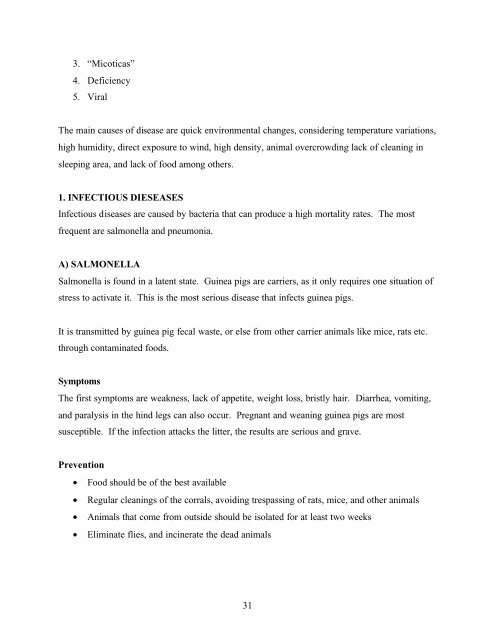GUINEA PIG MANAGEMENT MANUAL - Benson Institute
GUINEA PIG MANAGEMENT MANUAL - Benson Institute
GUINEA PIG MANAGEMENT MANUAL - Benson Institute
You also want an ePaper? Increase the reach of your titles
YUMPU automatically turns print PDFs into web optimized ePapers that Google loves.
3. “Micoticas”<br />
4. Deficiency<br />
5. Viral<br />
The main causes of disease are quick environmental changes, considering temperature variations,<br />
high humidity, direct exposure to wind, high density, animal overcrowding lack of cleaning in<br />
sleeping area, and lack of food among others.<br />
1. INFECTIOUS DIESEASES<br />
Infectious diseases are caused by bacteria that can produce a high mortality rates. The most<br />
frequent are salmonella and pneumonia.<br />
A) SALMONELLA<br />
Salmonella is found in a latent state. Guinea pigs are carriers, as it only requires one situation of<br />
stress to activate it. This is the most serious disease that infects guinea pigs.<br />
It is transmitted by guinea pig fecal waste, or else from other carrier animals like mice, rats etc.<br />
through contaminated foods.<br />
Symptoms<br />
The first symptoms are weakness, lack of appetite, weight loss, bristly hair. Diarrhea, vomiting,<br />
and paralysis in the hind legs can also occur. Pregnant and weaning guinea pigs are most<br />
susceptible. If the infection attacks the litter, the results are serious and grave.<br />
Prevention<br />
• Food should be of the best available<br />
• Regular cleanings of the corrals, avoiding trespassing of rats, mice, and other animals<br />
• Animals that come from outside should be isolated for at least two weeks<br />
• Eliminate flies, and incinerate the dead animals<br />
31



